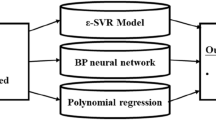Abstract
Industrial robots have been introduced to the belt grinding of free-form surfaces in order to obtain high-quality products and high-efficiency. One of the critical problems of high-precision belt grinding is to compute the force distribution in the contact area between the workpiece and elastic grinding wheel. The finite element method (FEM) is the traditional way to solve such a contact problem. However, the FEM model is too time-consuming. Normally, a single calculation takes several minutes on a powerful PC, which is unacceptable for real-time simulations and on-line robot control. A new model based on a neural network (NN) technique is developed instead of the FEM model to calculate the force distribution. The new model approximates the old FEM model with an acceptable tolerance but can be executed much faster than FEM model. With this new model, real-time simulation and on-line robot control of grinding processes can be further conducted.
Similar content being viewed by others
References
Hammann G (1998) Modellierung des Abtragsverhaltens elastischer robotergeführter Schleifwerkzeuge. Dissertation, Stuttgart University
Schueppstuhl T (2003) Beitrag zum Bandschleifen komplexer Freiformgeometrien mit dem Industrieroboter. Dissertation, Dortmund University
Blum H, Suttmeier F-T (2000) An adaptive finite element discretisation for a simplified signorini problem. Calcolo 37(2):65–77
Blum H, Schroeder A, Suttmeier F-T (2003) A posteriori error bounds for finite element schemes for a model friction problem. In: Proceedings of Simulation Aided Offline Process Design and Optimization in Manufacturing Sculptured Surfaces, Witten-Bommerholz, Germany, pp 39–47
Suttmeier F-T. Error analysis for finite element solutions of variational inequalities. Dissertation, Dortmund University
Krause RH (2001) Monotone multigrid methods for signorini’s problem with friction. Dissertation, Free University of Berlin
Cybenko G (1989) Approximation by superpositions of a sigmoidal function. Math Control Signals Syst 2:303–314
Hornik K, Stinchcombe M, White H (1989) Multilayer feedforward networks are universal approximators. Neural Netw 2(5):359–366
Haykin S (1995) Neural networks – a comprehensive foundation. Macmillan, Houndsmills
Riedmiller M, Braun H (1993) A direct adaptive method for faster backpropagation learning: the RPROP algorithm. In: Proceedings of the IEEE International Conference on Neural Networks, San Francisco, pp 586–591
Hagan MT, Menhaj M (1994) Training feedforward networks with the marquardt algorithm. IEEE Trans Neural Netw 5(6):989–993
Ernest R, Bellman E (1961) Adaptive control processes: a guided tour. Princeton University Press, Princeton
Donoho DL (2000) High-dimensional data analysis: the curses and blessings of dimensionality. In: Proceedings of the AMS Conference Mathematical Challenges of the 21st Century. http://www-stat.stanford.edu/∼donoho/Lectures/AMS2000/Curses.pdf
Demuth H, Beale M (2001) Neural network toolbox user guide. Mathworks, Natick, USA
Jolliffe IT (1986) Principal component analysis. Springer, Berlin Heidelberg New York
Author information
Authors and Affiliations
Corresponding author
Rights and permissions
About this article
Cite this article
Zhang, X., Kneupner, K. & Kuhlenkötter, B. A new force distribution calculation model for high-quality production processes. Int J Adv Manuf Technol 27, 726–732 (2006). https://doi.org/10.1007/s00170-004-2229-x
Received:
Accepted:
Published:
Issue Date:
DOI: https://doi.org/10.1007/s00170-004-2229-x



